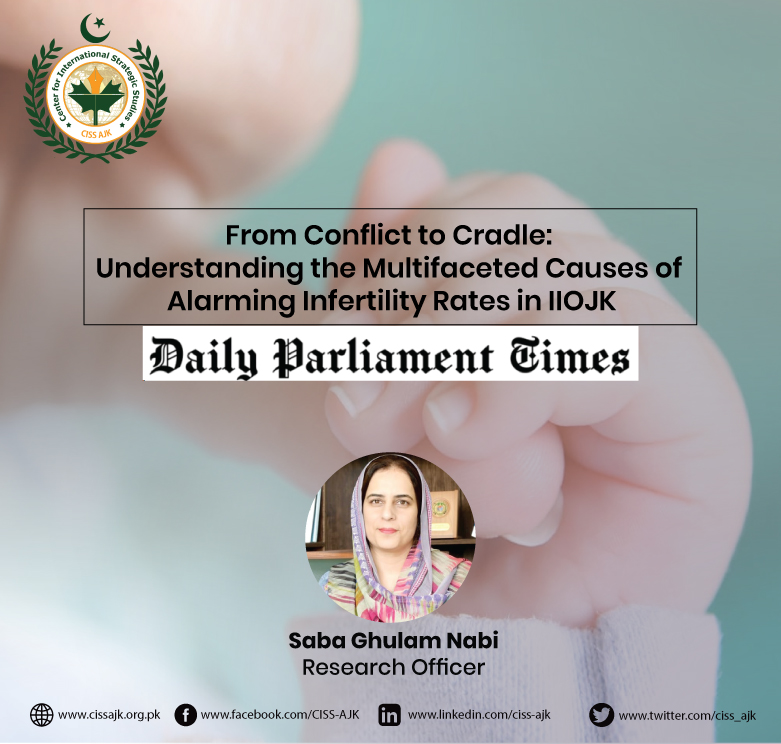491
Conflict affects every part of life, causing problems in physical, social, economic, and psychological aspects. It not only damages physical structures but also disrupts family life in societies facing conflict. The situation in Indian Illegally occupied Jammu and Kashmir is worse than many other conflict zones, with higher mortality rates and a significant impact on fertility. Recent data from the National Family Health Survey (NFHS) for 2019-21 shows a sharp decline in the total fertility rate (TFR) in Jammu and Kashmir. The rate dropped from 2 to 1.4, much lower than the national average of 2 since 2015-16. Even during the unrest in 2015-16 after the demise of Burhan Wani, the fertility rate was 2. However, after the illegal attempt of Modi’s government to change the status of the state and the subsequent curfew and lockdown, it further decreased to 1.4, below the replacement fertility rate. The replacement fertility rate is 2.1, which is crucial for a society’s survival. Low fertility rate is the cause of distress in societies so much so that some developed countries like Singapore offer incentives to their citizen to increase family size. In those countries, maintaining the family size is an individual’s choice, unlike Kashmir. In Indian Illegally Occupied Jammu and Kashmir, the situation is imposed by external factors rather than individual choices. Not only has the fertility rate fallen, but infertility has also increased to 17.5%. Dr Farhat, an obstetrician in Srinagar, attributes this trend to many factors like unemployment, physiological impact of conflict, dowry and late marriages which contribute to.
There are number of causes for late marriages in Kashmir like lavish weddings, prioritising government jobs, finding a partner in a particular caste/class and family against choice marriages. Scientifically, psychological stress affects fertility. Dr Kristin L. Rooney’s study in Massachusetts, USA, suggests that 25% to 60% of infertility cases result from psychological stress. In Indian Illegally occupied Jammu and Kashmir, another study found that 45% of the adult population (1.8 million) experiences mental distress. This increase in mental illness and psychological issues ultimately contribute to increased infertility in Indian Illegally Occupied Jammu and Kashmir. The change in lifestyle impacts fertility to a larger extent but conflict also plays a vital role in infertility. Late marriage is another main cause of infertility. Dr Farhat says “The peak fertility of women is between 18 and 25 years, but nowadays most of the women get married either in their late 20s or early 30s, by the time there is already a significant decline in their fertility.” Professor Dabla’s 2007 study Emergence of late marriages in Kashmir revealed over the past three to four decades, the average marrying age increased from 24 to 32 for men and 21 to 28 for women, up from 23 and 20 years previously. Understandably, it has an effect on the fertility rate. While late marriage is an increased trend,
remaining single is another factor in lowering the total fertility rate. The Youth in India – 2022 report by the Ministry of Statistics and Programme Implementation shocked Kashmir by highlighting it as the state with the highest percentage of unmarried youth in 2019, reaching 65%. This trend, with 45% of females and 20% of males remaining single, is attributed to the conflict. Uncertain conditions in Jammu and Kashmir lead males to move to Indian cities or foreign countries for education and employment, causing an imbalance in Kashmir. Among other factors, the economic conditions, worsened by conflict can also be considered as a cause of remaining single or marrying late, hence sharpening the fall in fertility rate further. Conflict is not only a game of swords and explosives. Conflict destroys the complete social fabric of the areas affected by conflict. Conflict does not only kill, it leaves the land barren and laps deserted. In essence, beyond the geopolitical intricacies, conflict paints a sombre picture of disrupted lives, shattered dreams, and a compromised future for the people of Indian Illegally Occupied Jammu and Kashmir. As we grapple with the statistics and narratives presented, it is imperative to recognize the urgency of addressing not only the visible wounds of conflict but also the deeply embedded societal challenges it leaves in its wake. The call for resolution extends beyond political negotiations; it encompasses the restoration of the social fabric, the rebuilding of shattered dreams, and the healing of the human spirit in a region scarred by conflict.

